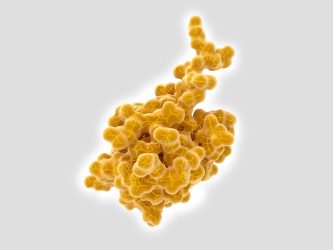A novel assay to reveal cyclic peptides with affinity to ubiquitin
Posted: 31 March 2021 | Victoria Rees (Drug Target Review) | No comments yet
Although macrocyclic peptides make for promising pharmaceutical candidates, screening for lead peptides has proved difficult for scientists. In a new study, researchers at the Technion-Israel Institute of Technology addressed these challenges by developing a novel high-throughput screening assay for cyclic peptides with affinity to the ubiquitin protein. Drug Target Review’s Victoria Rees explores the study and discusses how the new assay could lead to new drug candidates against cancer.


The identification of new cancer drugs is desperately needed worldwide. In 2018, there were 9.6 million deaths and 17 million new cases of cancer globally.1 However, revealing which small molecules or biopharmaceuticals work best against the condition is no easy task. One potential strategy for combatting cancer is through using cyclic peptides that work in collaboration with the ubiquitin system. To discover novel peptides, researchers have developed a high-throughput assay that can be used during screening, outlined in their study published in Angewandte Chemie.2
Exploiting ubiquitination
Ubiquitin is a small cellular protein that helps to degrade proteins and induce cell death. The molecule tags dysfunctional proteins and marks them for degradation.


Several ubiquitin-proteasome system components have been identified and validated as potential anticancer targets. According to previous research, various proteasome inhibitors have been approved by the US Food and Drug Administration (FDA) for the treatment of and range of liquid tumours.4
Making macrocyclic peptides
Drugs based on peptides are usually too large to pass through cell membranes. To make these more compact and stable for use, one option is to utilise the closed version. These have the potential to modulate regulatory proteins, which the researchers from the study emphasise is an important goal in cancer research.
The team subjected peptides to alkylation arylation, oxidation and dimerisation, which was the first step in making the required polycyclic peptides. The researchers believe that cyclisation makes the peptides more stable than their open analogues and their compact shapes help them to enter cells more easily.
From here, the researchers then developed a monocyclic peptide to be used within their study. They say this peptide selectively binds K48-linked tetra-ubiquitin (tetra-UbK48) chains with high affinity, triggering early- and late-stage apoptosis in cells.
Difficulties in screening
Drugs based on peptides are usually too large to pass through cell membranes”
Despite the potential of peptides in cancer therapeutics, screening for macrocyclic peptides remains challenging. According to the researchers, this is because well-established screening approaches need highly-expensive instrumentation and the training to operate required techniques.
One alternative is a competitive binding strategy, which involves a contest between labelled and unlabelled ligands for the available binding site on the target. However, this strategy requires a homogenous target and labelled ligand with characterised binding parameters.
The development of an assay
The researchers prepared dimers of the cyclic ubiquitin-binding peptides, where two identical cyclic peptides are linked together. They then designed a simple screening assay based on the competitive binding approach. This enabled unknown peptides to be tested for their capabilities to displace a known peptide with known binding affinity to a target. The assay was developed to progress through the following steps:
- biotin tagged tetra-UbK48 was immobilised in a constant amount in a 96-well plate
- the unlabelled peptides were incubated in excess in each well to saturate binding to the target and the unlabelled peptide with known binding parameters was also introduced into one of the wells for the calculation of relative affinity
- fluorescein-5-maleimide labelled peptide‑standard was introduced to compete with the unlabelled peptides
- the bound peptides were released from the wells by treatment with guanidine hydrochloride solution, followed by a measurement of fluorescence.
The readout was the change in fluorescence, provided by a fluorescent label attached to the known peptide. This enabled the identification of unknown peptides that bind to the target. The researchers say that this approach enables fast, high-throughput, cheap and easy‑to‑implement screening of peptide libraries.
Promising findings
Having formulated their fluorescence method, the team was able to utilise their assay to identify peptides that bind strongly to the Lys48-linked tetraubiquitin chain.


Using confocal microscopy, the researchers found these dimeric cyclic peptides exhibited cell permeability, despite the size difference with the monomeric peptide, entering the cells easily and inducing cell death. Conducting a viability assay using flow cytometry, the team assessed the cellular effect of the peptide, discovering that they were more potent than the control moncyclic peptide analogue.
Conclusion
In their paper, the researchers say that a dimeric peptide they identified showed promise as a cancer therapeutic. Demonstrated via their new assay, this version warrants further studies using in vivo models and could be a key strategy in the fight against cancer.
The labelled dimeric peptide has the potential to be used as a specific staining agent for ubiquitin with antibody-like properties”
The team also suggest that the macrocyclic peptides could also be optimised to make them more functional. Through the introduction of various chemical modifications such as the attachment of cationic or hydrophobic tags, or changing the linker’s nature, it may be possible to further improve the permeability of the dimeric peptide which would be translated to enhanced biological activity.
Regarding the assay, the scientists suggest it can be adopted for other various ubiquitin chains in their free or anchored forms as well as conjugates for ubiquitin-like modifiers. The labelled dimeric peptide has the potential to be used as a specific staining agent for ubiquitin with antibody-like properties, where live cells could be visualised without a need for permeabilisation. This would enable the exploration of ubiquitin chain dynamics in real-time conditions.
About the author
Victoria Rees is the Deputy Editor of Drug Target Review.
Reference
- Worldwide cancer statistics [Internet]. Cancer Research UK. 2021 [cited 21 March 2021]. Available from: https://www.cancerresearchuk.org/health-professional/cancer-statistics/worldwide-cancer#heading-One
- Vamisetti G, Meledin R, Nawatha M, Suga H, Brik A. The Development of a Fluorescence‐Based Competitive Assay Enabled the Discovery of Dimeric Cyclic Peptide Modulators of Ubiquitin Chains. Angewandte Chemie International Edition. 2021;60(13):7018-7023.
- Targeted protein degradation: the next wave of therapeutics [Internet]. Drug Target Review. 2021 [cited 21 March 2021]. Available from: https://www.drugtargetreview.com/article/57497/targeted-protein-degradation-the-next-wave-of-therapeutics/
- Yang H, Chen X, Li K, Cheaito H, Yang Q, Wu G et al. Repurposing old drugs as new inhibitors of the ubiquitin-proteasome pathway for cancer treatment. Seminars in Cancer Biology. 2021;68:105-122.
Related topics
Assays, High-Throughput Screening (HTS), Peptide Therapeutics, Screening
Related conditions
Cancer
Related organisations
Horizon Discovery, Technion-Israel Institute of Technology, US Food and Drug Administration (FDA)








